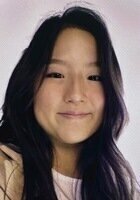Explanation:
To answer this question correctly, you need to understand the difference between solid lines and dashed lines in View Recognition/Top-Front-End questions. Solid lines refer to lines and edges that you can see in a particular view, whereas dashed lines refer to lines and edges that are obscured by something in front of them from that particular view. One tricky part about this question is that when shapes involve angles, the edge on which the vertex of the angle is located is also represented by a line, solid or dotted as necessary.
Considering the front view, we're shown a rectangular face bisected by a dotted line. This tells us that an angle is involved. If a shape built from ninety-degree angles were involved, an even number of lines would be necessary. Since we only see one line, we know that two faces must be coming to a point, either pointing outward from the face we're looking at directly, or inward. It's impossible to tell from just this view. Furthermore, the shape could be an equilateral triangle if these angled edges started at the corners we can see, but alternatively, those edges could extend in space into a prism for a while before angling toward that point. Again, it's impossible to tell from this view alone since these extensions and differences would all occur exactly on the edges we're looking at directly, and thus they wouldn't be shown in this diagram.
Let's now consider what we learn when we combine what we know from the Front View with what we learn from the End View. Now there are three vertical lines. One of them, the center one, is solid, so we are looking head-on at two angled faces. The point could either be coming toward us, away from the shape, or it could extend into the shape. We can't tell. The dotted lines tell us that there are two edges behind the face we're looking at. We don't know if these edges are in line with each other or not, and if they're not, we can't tell which one is closer to us.
Let's look at the answer choices. Since there are so many options as to what these diagrams could represent, let's use process of elimination to figure out which answer choices can't be correct and which one must be correct.

This shape can't be correct. While the face at bottom lines up with what we see from the end view (two angled faces meeting in the middle of the shape), the far side of the shape only has one face, not three. We need to see three different faces on the far side of this shape because there are two vertical dotted lines shown in the End View diagram.

This shape can't be correct either. While it would involve three faces behind the immediate view if we looked at the right side head-on, there is no angle like the one represented in the Front View diagram. Plus, this diagram is pointed in the wrong direction! Direction is important in Front-End-Side problems.

This shape is also incorrect. If we looked at the shape from the bottom, the triangular "indent" would extend much farther to the right of center than is shown in the Front View diagram. In addition, if we looked head-on at the right face of the diagram, we wouldn't see any edges that would match up with the solid vertical line in the End View diagram. That line would have to be dashed like the other two for the End View diagram to be correct.

This is the correct answer. If we look at the shape from the front, we see that the triangular indent extends to halfway between the solid vertical line that forms the left face and the points of the rightmost part of the shape. The vertical line would be represented by the left vertical line in the Front View, and the right vertical line would be represented by a line extending downward from the "points" of the right side of the shape. Since these points are in line with one another, only one line would be required for the right side in the Front View diagram. Seen from the right for the End View, the solid vertical line in the middle represents the middle of the indented angle, and the two vertical lines represent the edges where on the left part of the top view, the sides angle out from the vertical line.














